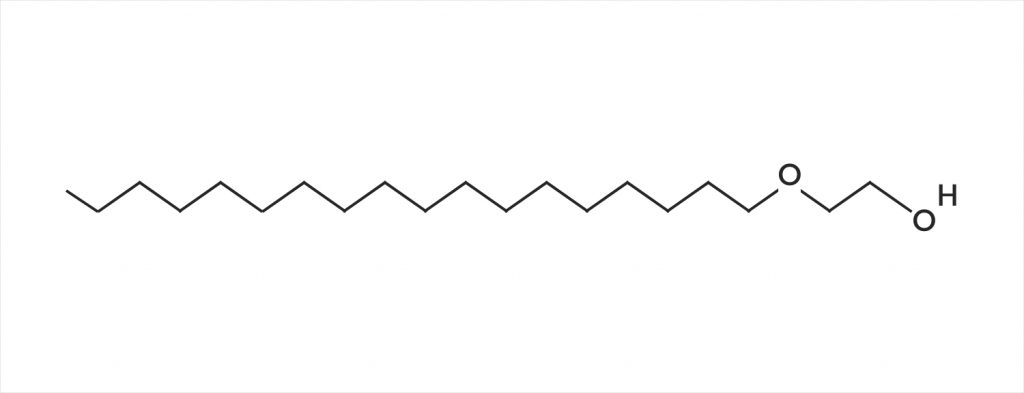What Is Ceteareth-20?
Ceteareth-20 is a skincare and cosmetic ingredient used to improve the texture and stability of products. Ceteareth is a synthetic compound that functions as an emulsifier and surfactant in formulations.
If you’re researching ceteareth-20, you might be looking for clean yet effective skincare. One brand we recommend is Carrot & Stick. You can read more about this brand at the bottom of the article.
The group of ceteareth ingredients are synthetic compounds that are synthesized through a process known as ethoxylation, a chemical reaction in which ethylene oxide is added to a substrate. In regards to the ceteareth ingredients, there are two substrates: cetyl alcohol and stearyl alcohol, which are both naturally derived from coconut oil. The number associated with the ceteareth- 20 indicates the average number of repeating ethylene oxide units in the molecule, in this case 20. There are a total of 32 different types of ceteareth ingredients.

Ceteareth-20
the good:Ceteareth-20 helps to improve the texture and stability of a product.
the not so good:There are concerns about the presence of 1,4-dioxane in this ingredient. This concern is less relevant nowadays as the process of purifying ceteareth-20 is highly regulated.
Who is it for?All skin types except those that have an identified allergy to it.
Synergetic ingredients:Works well with most ingredients.
Keep an eye on:Nothing to keep an eye on here.
What Is Ceteareth-20 Used For?
Ceteareth-20 functions as a surfactant and an emulsifier in many different cosmetics and skincare products, including facial moisturizers, anti-aging treatments, conditioners, cleansers, sunscreens, exfoliants, and acne treatments.
Surfactant
Surfactant is the other name for surface active agents. Surfactants are compounds that lower the surface tension between two substances, such as two liquids or a liquid and a solid. In skincare products, surfactants work to degrease and emulsify oils and fats and suspend dirt, allowing them to be washed away. This is possible because while one end of the surfactant molecule is attracted to water, the other end is attracted to oil. Thus, surfactants attract the oil, dirt, and other impurities that have accumulated on your skin during the day and wash them away. Due to these properties, ceteareth-20 can be found in many different cleansers and body washes.
Emulsifier and stabilizer
Ceteareth-20 also functions as an emulsifier. An emulsifier is needed for products that contain both water and oil components, for example, when oils are added to a water-based formula. When water and oil are mixed together they will often separate and split in the product over time. To address this problem, an emulsifier can be added to produce a stable emulsion.
As an emulsifier, ceteareth-20 consists of a water-loving hydrophilic head and an oil-loving hydrophobic tail. The hydrophilic head is directed to the aqueous phase and the hydrophobic tail to the oil phase. Once again, ceteareth-20 reduces the surface tension by positioning itself at the oil/water or air/water interface, which has a stabilizing effect on the emulsion.
Is Ceteareth-20 Safe?
The Cosmetic Ingredient Review (CIR) Expert Panel, a group responsible for evaluating the safety of skincare and cosmetic ingredients reviewed the scientific data and concluded that the ceteareth ingredients were safe as used in cosmetic products. The CIR Expert Panel noted that ceteareth ingredients should not be used on damaged skin. This conclusion was based on research that kidney damage resulted when polyethylene glycol (PEG) ingredients were applied to the damaged skin of burn patients. Since ceteareth ingredients are the polyethylene glycol ethers of cetearyl alcohol, the CIR Expert Panel recommends avoiding use of ceteareth ingredients on damaged skin.
Despite the approval by the CIR Expert Panel, ceteareth-20 is often called a ‘toxic’ ingredient that should be avoided. One reason ceteareth-20 has received a bad reputation is due to possible contamination with 1,4-dioxane. This is because the process of ethoxylation may lead to contamination with 1,4-dioxane, a potentially dangerous by-product. 1,4-dioxane is a known animal carcinogen that penetrates readily into the skin. According to the National Toxicology Program, ‘1,4-dioxane is reasonably anticipated to be a human carcinogen.’ It has also been linked with skin allergies. However, the potential presence of 1,4-dioxane can be controlled through purification steps to remove it before blending ceteareth-20 into cosmetic formulations.







